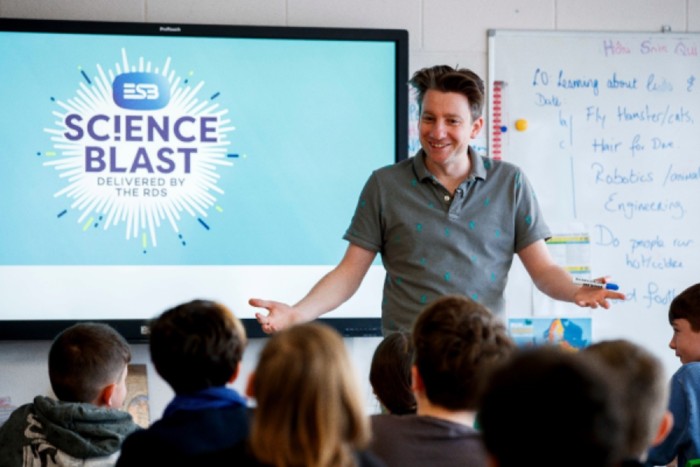
My name is Phil and I’m a scientist – and I love being known as one. By being a scientist, people assume that I am smart, which I’m totally fine with. It’s like a badge of honour and I love showing people, especially children, what science can do for them.
My personal journey through science has equipped and empowered me with the confidence to always try new things and enjoy the process of answering any type of question.
Throughout this blog, I will explore some of my thoughts behind engagement in STEAM (Science, Technology, Engineering, Art and Maths) and ESB’s Generation Tomorrow programme, which aims to provide the young people of Ireland with the skills they will need to thrive in the future.
“I have not failed. I've just found 10,000 ways that won't work.”
In science, not knowing something presents the greatest opportunity to explore. From a simple question; you predict, observe, analyse, investigate, experiment, estimate, measure, record and communicate. Kids love doing these things too, even if they don’t have these same labels for how they are trying to work out the answer to a question.
For me, I love this process and my confidence in coming up with a solution to a difficult question is thanks to my scientific knowledge. I believe that following this process and the values associated with it, allows people, particularly children, to see the value in themselves by coming up with innovative and creative solutions to problems and questions.
Discovering the ‘why’
Being comfortable with not knowing the answer and understanding that getting it wrong along the way is part of the process, is key to helping you build self-confidence. Children’s questions may be straightforward, but the answers can be the most complex.
Think of why is the sky blue, why do wasps exist or how is wood so strong? We sometimes struggle to answer these questions for children, often due to a lack of scientific knowledge, understanding or confidence. As a result, children may stop asking questions because their source of information isn’t able to help, leading to a decreased future interaction with science. Therefore, highlighting STEAM and the people who use it, to children, parents and teachers is crucial for our future. This needs to happen early and often for it to take root, as research suggests that children begin to decide about their general career choice by age seven.
We want to highlight how working scientifically is a tool that can be used no matter your profession or lifestyle. Science is not confined to a lab, it is everywhere and universal. What we are trying to do via projects such as Phil’s Science Lab on Ireland AM and Curiosity Hub on Today FM, is present the power of STEAM in an entertaining and engaging way.
Exploring with science
With any experience, you want to encourage children to explore exciting science through play and inquiry-based learning. A clear start is allowing children to lead the learning through play, which encourages their ownership of the question they are asking. Then, having them present their findings in a critical way improves their evaluation and communication skills.
To me, ESB’s Generation Tomorrow programme serves as the hub for content creation and sharing across multiple platforms. It is designed to support various partners that are dedicated to empowering young people to reach their potential and power their collective brighter future.
This is a big goal, but where I feel that ESB is different is that they are investing heavily in long-term strategies across multiple platforms to engage with a more diverse audience, as well as utilising multiple complementary approaches to learning. They are living their vision with value-based actions and getting their staff involved in a way that few others can match. We are not looking to turn everyone into a scientist, we are here to show the power of science by raising the science capital of children through multiple and varying interactions.
Building science capital for the future
Science capital can be defined as the sum of all the science-related knowledge, attitudes, experiences and resources that an individual accumulates throughout their life. This includes what science they know about, what they think about science, the people they interact with who understand science and the day-to-day engagement they have with all things scientific.
Think of it this way: picture a child with a magical backpack in which they store all their memories and interactions that they have had with science throughout their life. These interactions are broken down into what you know, how you know, what you do and who you know. The number of positive interactions, i.e. the amount of science capital that they have, influences whether a child thinks science is for them or not. Through the Generation Tomorrow programme, ESB is providing multiple opportunities for children to not only fill their science capital backpack, but also improve their communications, teamwork, social and other easily transferrable skills.
What’s next?
In future posts, I will explain more about sustainability and accessibility, before exploring some of the tools that we’ve been using like science capital, tinkering and inquiry-based learning. I will also show you how to make entertaining content and why it is key to actually take part in your own experiments. I may even give some insights into my amazing jokes which I’m sure will excite you the most!
To find out more about ESB’s Generation Tomorrow programme and to see how you can get involved click here.
Phil Smyth is a physicist, engineer and broadcaster who has worked in science communication for the past 18 years. Currently, he is the Impact and Outreach Scientist for UCD Discovery, the National Touring Co-ordinator of PLASTIC at Science Gallery Dublin and Director of Simply Science. Phil has presented over 350 segments on television and radio, and is passionate in people seeing the value in themselves through science, technology, engineering, art and maths. You can find him on Twitter: @phildublin82 and Instagram: @philofscience
